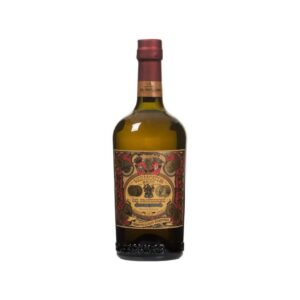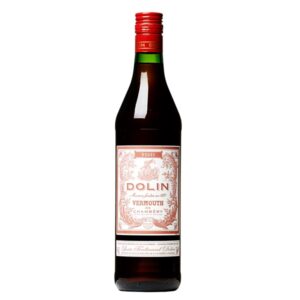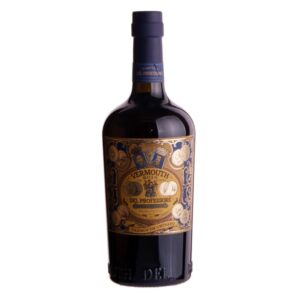Showing all 3 resultsSorted by popularity
Vermouth – The Complete Guide
TL;DR: In Short
- Vermouth is characterized by being an aromatized, fortified wine infused with botanicals
- It’s primarily made from wine, neutral spirits, and a proprietary blend of herbs, spices, roots, and barks
- It comes in several styles, including dry (white), sweet (red), and bianco (white but sweeter)
- Best enjoyed chilled, over ice, or in classic cocktails like the Martini, Manhattan, or Negroni
Disclaimer: This guide is intended for informational purposes for adults over 18 years of age. Vault of Spirits encourages responsible alcohol consumption.
Introduction to Vermouth
Vermouth has a rich history and fascinating craftsmanship behind it. From its origins in Italy and France to its global popularity today, this fortified wine has evolved to become one of the world’s most treasured cocktail ingredients.
This guide provides insight into the production, flavor profiles, and enjoyment of vermouth, whether you’re a beginner or experienced enthusiast.
At its core, vermouth is a clever marriage of wine, spirits, and botanicals – creating a product that’s greater than the sum of its parts and has been captivating palates for centuries.
How Did Vermouth Originate?
From Past to Present
Vermouth’s story begins in ancient times when wine was infused with herbs and spices, primarily for medicinal purposes.
The modern vermouth we know today emerged in Turin, Italy in the late 18th century when Antonio Benedetto Carpano created a formula by infusing white wine with over 30 herbs and spices.
The name “vermouth” itself comes from the German word “wermut” (wormwood), one of the key botanical ingredients originally used.
By the early 19th century, vermouth production had expanded to France, where drier styles were developed in contrast to Italy’s sweeter versions.
Which Historical Milestones Have Shaped Vermouth?
A significant milestone came in 1786 when Antonio Carpano established his formula in Turin, effectively launching commercial vermouth production.
In 1813, Joseph Noilly created the first French dry vermouth, establishing the distinction between sweet Italian and dry French styles that persists today.
The late 19th century saw the foundation of major vermouth houses including Martini & Rossi, Cinzano, and Dolin, which helped spread vermouth’s popularity globally.
The cocktail revolution of the early 20th century cemented vermouth’s importance as a key ingredient in classics like the Martini and Manhattan.
How Has Vermouth Influenced Cultural Traditions?
In Mediterranean countries, particularly Spain and Italy, vermouth has developed into a distinct drinking culture known as “la hora del vermut” (vermouth hour).
This tradition involves enjoying vermouth as an aperitif before lunch or dinner, often accompanied by small tapas or appetizers.
In France, particularly in Paris, the “cinq à sept” (five to seven) evening aperitif hour became culturally significant, with vermouth drinks taking center stage.
Vermouth has also influenced literary and artistic scenes, appearing in works by Ernest Hemingway and becoming a symbol of sophistication in cinema.
Why Is Vermouth Popular Today?
Vermouth is experiencing a renaissance, driven by craft cocktail culture and renewed interest in traditional aperitifs.
Bartenders have rediscovered vermouth’s versatility and complexity, elevating it from mere cocktail ingredient to star of the show.
Small-batch, artisanal vermouth producers have emerged worldwide, experimenting with local botanicals and wine varieties.
Low-alcohol beverages are increasingly popular, and vermouth’s moderate ABV (typically 15-18%) makes it perfect for contemporary drinking preferences.
How Is Vermouth Made?
Which Raw Materials Are Used in Production?
The foundation of any vermouth is wine, typically made from neutral grape varieties that won’t overshadow the botanical flavors.
Primary ingredients:
- Base Wine – Provides the foundation and determines whether it will be a red or white vermouth
- Fortifying Alcohol – Usually neutral grape spirits that increase the alcohol content and stability
- Botanicals – A proprietary blend of herbs, spices, roots, barks, and flowers that give vermouth its distinctive character
Common botanicals include wormwood (historically the defining ingredient), gentian, cinchona, citrus peel, cinnamon, clove, chamomile, and dozens of others.
Many producers also add sugar, caramel, or grape must to achieve desired sweetness levels and color.
How Does the Infusion Process Work?
Unlike fermentation-focused spirits, vermouth’s character comes primarily from botanical infusion.
Producers use several methods to extract flavors from botanicals:
Maceration involves soaking botanicals directly in the wine or spirit base for varying periods.
Percolation passes the wine through a basket of botanicals, similar to coffee brewing.
Distillation of botanical-infused alcohol creates concentrated flavor essences that are added to the base.
Each vermouth house guards its botanical recipe and infusion technique as closely-held secrets, often passed down through generations.
Which Production Techniques Are Used?
After infusion, the vermouth undergoes several refining steps:
Common production methods:
- Blending – Combining different infusions, wines, and spirits to achieve a consistent house style
- Fortification – Adding neutral grape spirits to increase alcohol content and stability
- Filtration – Removing particulate matter while preserving aromatic compounds
Some producers use techniques like cold stabilization to prevent cloudiness and ensure quality over time.
Most vermouths undergo a resting period to allow flavors to integrate before bottling.
What Significance Does Aging Have?
Unlike many spirits, vermouth isn’t typically aged for extended periods.
Some premium vermouths may rest in tanks or barrels for a few months to allow flavors to marry.
Oxidation, while detrimental after opening, plays a controlled role during production in developing certain flavor characteristics.
Vermouth is generally bottled when ready to drink and doesn’t continue to develop positively in the bottle over years like wine or whiskey.
Which Regions Are Known for Vermouth?
Where Are the Best Variants Produced?
Italy, particularly Turin (Torino), is the birthplace of sweet red vermouth and remains a production center.
France, especially the alpine region of Chambéry, is renowned for its distinctive dry white vermouth style.
Spain, particularly Catalonia and Reus, has developed its own vermouth tradition with distinctive herbaceous and slightly bitter profiles.
New producers have emerged in the United States, Australia, and the UK, bringing fresh perspectives to this traditional product.
How Do Geography and Climate Affect the Taste?
The wine base reflects regional grape varieties and growing conditions.
Local botanical traditions influence the herb and spice blends used in different regions.
Italian vermouths often feature Mediterranean herbs and greater sweetness, while French styles tend to be drier with alpine botanicals.
Spanish vermouths frequently incorporate local herbs and often have a distinctive bittersweet quality.
What New Trends Are Seen in Vermouth Production?
Craft producers are experimenting with unusual base wines, including orange wines and natural wines.
Local and foraged botanicals are being utilized to create vermouths with a strong sense of place.
Some producers are exploring barrel aging and special cask finishes to add complexity.
Low-intervention and organic production methods are becoming more common as consumer preferences evolve.
What Do the Different Quality Designations Mean?
Unlike wine or spirits like Cognac, vermouth lacks a comprehensive global classification system.
European regulations define vermouth as an aromatized wine containing wormwood with a minimum alcohol content of 14.5% to 22% ABV.
Terms like “extra dry,” “dry,” “semi-sweet,” and “sweet” refer to sugar content but aren’t strictly regulated globally.
Geographical indications like “Vermouth di Torino” provide protected status to products from specific regions made according to traditional methods.
How Does Vermouth Taste?
What Characterizes the Typical Flavor Profile?
Vermouth presents a complex interplay of bitter, sweet, herbal, and wine notes.
Typical aromas:
- Botanical – Herbs, wormwood, gentian, chamomile, thyme
- Spice – Cinnamon, clove, vanilla, star anise, cardamom
- Fruit – Citrus peel, dried fruit, stone fruit, berries
The palate typically offers a balance of sweetness and bitterness with vinous qualities from the base wine.
Texture ranges from light and crisp in dry varieties to rich and mouth-coating in sweet styles.
How Does the Flavor Vary Between Different Styles?
Dry (French-style) vermouth is crisp and light with pronounced herbal notes, subtle bitterness, and minimal sweetness.
Sweet (Italian-style) vermouth is rich with vanilla, caramel, and dried fruit notes balanced by gentle bitterness.
Bianco vermouth offers a vanilla-forward sweetness with lighter color and more floral characteristics.
Amber/gold vermouth sits between sweet and dry styles with honey notes and moderate sweetness.
Regional variations like Spanish vermouths often feature distinctive herbal profiles and a particular bittersweet balance.
How Does the Flavor Develop Over Time?
Unlike wine or spirits, vermouth doesn’t improve with age in the bottle.
Once opened, vermouth begins to oxidize, initially developing more nutty, sherry-like notes.
After several weeks of being open, vermouth loses its bright botanical notes and becomes flat and less vibrant.
Eventually, oxidation will turn vermouth vinegary and unpleasant – which is why proper storage is essential.
What Signs Reveal High Quality?
Superior vermouths display balanced complexity – neither one botanical nor sweetness should dominate.
Clarity of flavor with distinct, identifiable botanical notes indicates careful production.
Texture should be appropriate to style – silky for sweet, crisp for dry – without feeling thin or cloying.
A long, evolving finish that continues to reveal different flavor elements is a hallmark of premium vermouth.
How Is Vermouth Best Enjoyed?
What Is the Optimal Serving Method?
Straight vermouth is traditionally served chilled as an aperitif, often over ice with a citrus twist.
In the Spanish tradition, vermouth is served over ice with a slice of orange and sometimes an olive.
Dry vermouth can be enjoyed slightly chilled with a lemon twist.
Sweet vermouth works well slightly chilled with an orange twist or splash of soda.
Which Glass and Temperature Are Ideal?
A small wine glass or tumbler is traditional for neat vermouth.
Vermouth in cocktails is served in the appropriate glass for that specific drink (e.g., martini glass, coupe, or rocks glass).
Sweet vermouth is best served slightly chilled at about 55°F (13°C).
Dry vermouth is often preferred cooler, around 45°F (7°C), similar to white wine.
How Do You Taste Like an Expert?
First, assess the color – ranging from pale straw to deep amber or ruby depending on style.
Note the aroma, identifying the main botanical groups – herbal, spice, citrus, floral.
Taste small sips, allowing the vermouth to coat your entire palate.
Consider the progression from initial impression through mid-palate to finish, noting how different flavors emerge.
Evaluate balance between sweetness, bitterness, acidity, and alcoholic warmth.
Which Dishes Complement Vermouth?
Dry vermouth pairs beautifully with oysters, light seafood, and briny olives.
Sweet vermouth complements charcuterie, aged cheeses, and chocolate desserts.
All styles work well with salted nuts, potato chips, and light tapas.
The bitter components in vermouth make it excellent with fatty foods, as it cuts through richness and cleanses the palate.
Which Cocktails Can Be Made with Vermouth?
Which Classic Cocktails Should You Know?
Martini
Ingredients: Gin, dry vermouth, orange bitters (optional), lemon twist or olive
Preparation: Stir ingredients with ice, strain into a chilled cocktail glass, garnish
History: Evolved from the Martinez in the late 19th century, becoming progressively drier through the 20th century
Manhattan
Ingredients: Rye or bourbon whiskey, sweet vermouth, Angostura bitters, cherry
Preparation: Stir ingredients with ice, strain into a chilled cocktail glass, garnish
History: Created in the 1870s at the Manhattan Club in New York City
Negroni
Ingredients: Equal parts gin, sweet vermouth, and Campari, orange slice
Preparation: Stir ingredients with ice, strain into a rocks glass over ice, garnish
History: Invented in Florence, Italy around 1919 when Count Negroni asked for gin instead of soda in his Americano
Which Modern Cocktails Are Worth Trying?
Adonis – A lower-alcohol classic revival with sherry, sweet vermouth, and orange bitters
Bamboo – A sophisticated blend of dry vermouth, sherry, and bitters
White Negroni – Using Suze or Salers instead of Campari and dry vermouth for a different take on the classic
Vermouth Spritz – Sweet or dry vermouth, soda water, and prosecco for a refreshing low-ABV option
How Is Vermouth Enjoyed Neat?
Sweet vermouth works beautifully over ice with an orange twist.
Dry vermouth can be served chilled like white wine with a lemon twist.
A splash of soda water creates a refreshing, low-alcohol spritzer.
In Spain, vermouth is often served with a “sifón” (soda siphon) on the side, allowing guests to adjust dilution to taste.
Which Homemade Variants Can You Experiment With?
Infused vermouth can be created by adding fresh herbs, spices, or fruit to enhance existing flavors.
Try adding fresh citrus peels, vanilla bean, or star anise to sweet vermouth for 24-48 hours.
Experiment with adding fresh herbs like thyme, rosemary, or tarragon to dry vermouth.
House blends can be created by mixing different vermouths together – try combining sweet and dry in varying ratios.
What Should You Know Before Buying Vermouth?
Which Details Should You Pay Attention to When Buying?
Check the production date or bottling code if available – fresher is better with vermouth.
Look for vermouths stored away from direct light and heat in the store.
For cocktail making, consider the intended use – classic cocktails work best with traditional style vermouths.
If exploring premium sipping vermouths, look for products specifying the wine varietals used and botanical details.
What Do You Get for Your Money in Different Price Ranges?
Entry-level ($10-15): Standard mixing vermouths with straightforward profiles, perfect for classic cocktails
Mid-range ($15-25): Higher quality bases and more complex botanical blends, suitable for sipping or elevated cocktails
Premium ($25-40): Craft productions with distinctive botanical profiles, often using higher quality wine bases
Ultra-premium ($40+): Small-batch, artisanal vermouths with exceptional ingredient sourcing and unique production methods
How Is Vermouth Properly Stored?
Unlike spirits, vermouth should be refrigerated after opening.
Even refrigerated, an open bottle is best consumed within 4-6 weeks for optimal flavor.
If you use vermouth infrequently, purchase smaller bottles or consider vacuum wine preservation systems.
Store unopened bottles in a cool, dark place away from direct light and heat.
Is Vermouth a Good Investment?
Unlike fine wine or whiskey, vermouth is not typically collected or invested in for financial return.
Vintage vermouths are rare and mostly of historical interest rather than investment value.
Some limited-edition releases from artisanal producers may become collectible, but primarily for enthusiasts.
Vermouth is best treated as a consumable to be enjoyed fresh rather than an investment.
Which Brands Do We Recommend?
What’s Best for Beginners?
Dolin Dry: A light, accessible French dry vermouth that works beautifully in martinis
Cocchi Vermouth di Torino: A balanced sweet vermouth with classic flavors, perfect for Manhattans and Negronis
Martini & Rossi: Widely available and offering consistent quality across their range
Noilly Prat Original Dry: A historic brand with a distinctive profile that mixes well in cocktails
What Will Impress Enthusiasts?
Carpano Antica Formula: A rich, complex sweet vermouth with vanilla notes, often considered the gold standard
Del Professore: Italian craft vermouths with extraordinary depth and complexity
Lustau Vermut: Sherry-based vermouths with distinctive Spanish character
Contratto Bianco: A complex, aromatic white vermouth with exceptional depth
Which Bottles Are Most Sought After?
Giulio Cocchi Barolo Chinato: A rare vermouth-adjacent specialty made with Barolo wine
Bordiga vermouths: Small-production Italian vermouths with alpine botanicals
Mancino Vecchio: Barrel-aged vermouth with exceptional complexity
Limited-edition releases from craft producers like Uncouth Vermouth and Channing Daughters
Where Do You Get the Most for Your Money?
Dolin range: Excellent quality at moderate prices across dry, sweet, and blanc styles
Cocchi Americano: Versatile, quinine-infused aperitif wine that works beautifully in many applications
Punt e Mes: A distinctive bitter-sweet vermouth that offers tremendous character for cocktails
La Quintinye Vermouth Royal: French vermouths using Pineau des Charentes as a base, offering excellent value for their complexity
Frequently Asked Questions
What Is Vermouth?
Vermouth is an aromatized, fortified wine flavored with various botanicals (roots, barks, flowers, seeds, herbs, and spices) and sometimes colored.
It ranges from 15% to 22% alcohol by volume and comes in various styles, with sweet (red) and dry (white) being the most common.
Originally created for medicinal purposes, it evolved into an aperitif and now is most commonly used as a cocktail ingredient.
How Is Vermouth Produced?
Production begins with a base wine, to which a spirit (usually neutral grape brandy) is added for fortification.
A proprietary blend of botanicals is then infused through methods like maceration, percolation, or distillation.
The infused mixture is filtered, sometimes sweetened, and may be colored with caramel for certain styles.
After blending to achieve the desired style, the vermouth is filtered again and bottled.
What Characterizes Vermouth?
The defining characteristic is the bittersweet herbal flavor profile derived from botanicals, particularly wormwood (artemisia).
Sweet vermouths typically display notes of vanilla, caramel, citrus, and dried fruits with a rich mouthfeel.
Dry vermouths exhibit crisp, floral, and herbal notes with pronounced acidity and minimal sweetness.
All vermouths balance sweetness, bitterness, acidity, and alcoholic strength in their own distinctive way.
Where Can You Buy Vermouth?
Most liquor stores carry at least basic vermouth brands, typically in the wine section or alongside aperitifs.
Specialty wine shops often stock a wider selection of premium and craft options.
Online retailers offer the broadest range of vermouths, though shipping restrictions may apply depending on your location.
In Europe, vermouth can also be found in many supermarkets and specialty food stores.


